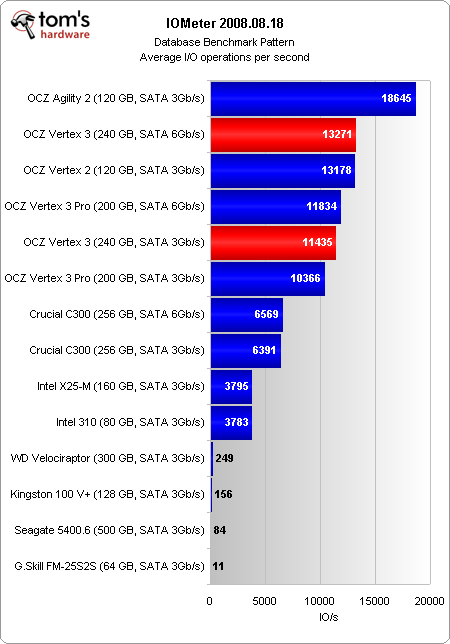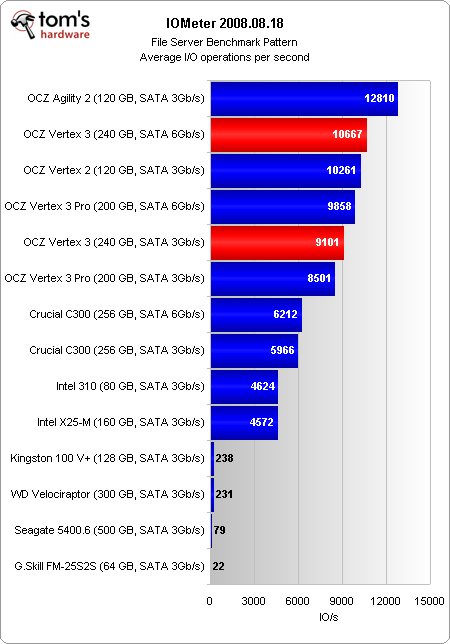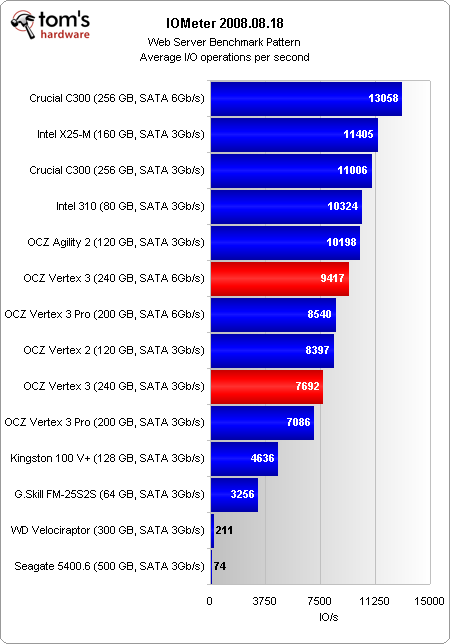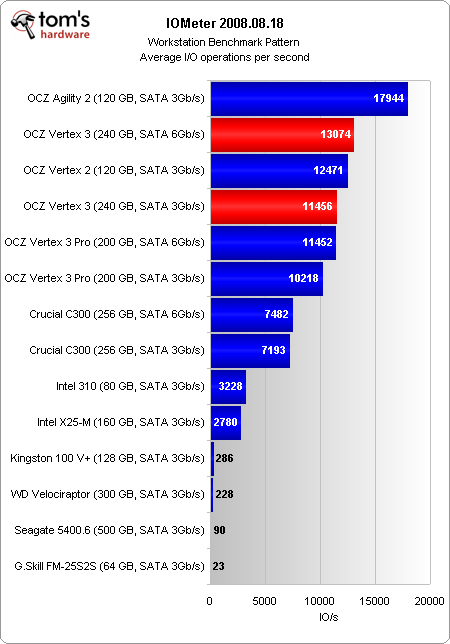OCZ's Vertex 3: Second-Generation SandForce For The Masses
Benchmark Results: I/O Performance
Last week, alidan, one of our forum regulars, requested that we test all SATA 6Gb/s drives (C300, Vertex 3, and Vertex 3 Pro) in a SATA 3Gb/s configuration, in addition to testing in 6 Gb/s ports. We're happy fulfill that request here. In the charts below, all 3 Gb/s results were taken from the corresponding ports on our H67 test platform.
Because we run all of our Iometer tests with a queue depth of one, these scores are more indicative of what you might see on a desktop or notebook. As a result, the majority of our tests here don't show the full potential of the Vertex 3 or Vertex 3 Pro.
Both of these drives were optimized for scenarios with concurrent requests. While high queue depths aren't something you would necessarily associate with the desktop-oriented Vertex 3, this is the consequence of sharing similar hardware and firmware with the Vertex 3 Pro.
Notice how far we have come from what many would consider a first-generation SSD? The G.Skill drive, based on JMicron's JMF602B, almost always finishes dead last. Only in the Web server benchmark do we see it peel away from the mechanical drives.
This chart is an excellent example of what SSDs do better than mechanical disks. A Web server very rarely writes data. Its main purpose is to deliver pages and graphics. As a result, the low latencies of solid state storage give SSDs a natural advantage.
Get Tom's Hardware's best news and in-depth reviews, straight to your inbox.
Current page: Benchmark Results: I/O Performance
Prev Page Test Setup Next Page Benchmark Results: Iometer Streaming-
lradunovic77 I agree and it is time for HDD to be retired. We don't need them anymore, but Servers.Reply -
bildo123 A far cry as far as "the masses" are concerned. Still, over $2/GB is too much. Getting closer however. I'd pay $200 for a 256GB SSD with these speeds.Reply -
acku mayankleoboy1the fact that they use ~15% of a quad core SB CPU, is amazing.with the mechanical drives, they were just sitting idle. this more than anything, makes the SSD worthwhile.Reply
Well what I didn't mention in the review is that the benchmark starts as ~20% across all cores during the first 10 seconds, which is from PCMark setting up the disk trace. After that, the IO activity throttles a single core up to 100% for almost all SSDs. For the hard drives, we see ~60-80% utilization of a single core.
Cheers,
Andrew Ku
TomsHardware.com -
lradunovic77 I say keep your desktop active all the time. I am running i980x overclocked to 4.0Ghz and there is no way i will put my computer into any type of power saving mode, it is useless and power saving is just mimick. We are talking about very small amount of money over a year. Having Turbo option makes sense from certain point of view but bottom line is that it is just wasted silicon and pretty much useless.Reply -
vvhocare5 "The problem is that any price above $2/GB is going to be a hard sell unless you're an early adopter by nature. Our choices in recent System Builder Marathon stories reflect this. Look at our December $1000 PC."Reply
Overall a good article. Anyone into MTBF's will find that one page uninforming and anyone not into it is likely lost.
I would disagree with that statement only in the sense that a $1000 PC is not going to be filled with high-end superior performing parts. So I dont see a reason to apologize for its price. The person who can afford a $3000+ PC isnt going to blink buying the 240G model and will likely see it as entirely reasonable.
Me? I think I have found my next ex-drive.....
-
acku Replyso as i said, will OC increase the scores a bit?
and what about power saving enabled?
None of our tests were executed in an environment that allowed any idling. Furthermore, we disabled CPU throttling. Power saving was enabled in the sense that the display was allowed to turn off, which is part of the default profile in Windows.
OCing may increase performance, but only to the extent that the bandwidth will support it. As I mentioned, PCMark throttles a single core up to 100%. It isn't a sustained trend. -
bto on your 1000 dollar gaming system, I'd rather have a vertex 3 than two 460's hell even an agility 2... and still afford better than a 460.Reply -
bto But then that's me, and to quote the great Inigo Montoya, "I hate wait" and most games I play are not bleeding edge, I also work on my computer, play HD movies and copying time makes me angry when I'm moving files. Buy an ssd, and later spend 60 bux on a 1tb drive down the road.Reply



